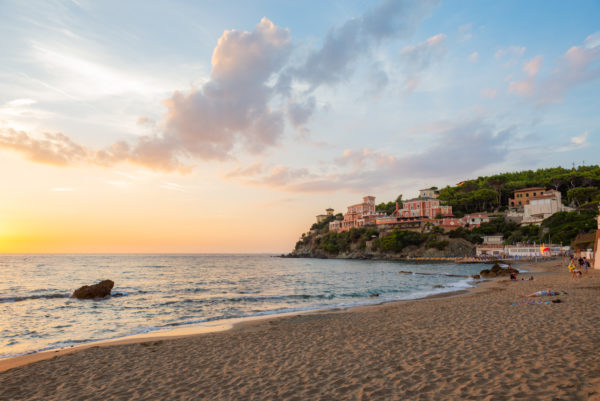Situated between the Ligurian Sea and the majestic coastal cliffs is Castiglioncello, a Tuscan resort town of renowned beaches. During the 1950s, the area was known for its palatial hotels and mansions, the sort of true haute living known today only in classic films.

The beauty of the location inspired film luminaries such as the legendary Federico Fellini, Luchino Visconti and Roberto Rossellini. And famous Italian actors like Marcello Mastroianni (star of many notable Fellini films), Vittorio Gassman (nicknamed the “Laurence Olivier of Italy”) and Suso Cecchi d’Amico (the award-winning actress who co-wrote the screenplay for Roman Holiday). Needless to say, Castiglioncello is a beautiful place.
The problem with glamour is that it fades over time, and, like many once-famous resort towns, Castiglioncello declined in popularity in the 1980s. In the past few years, however, the city has been making a comeback.
Its multi-million euro mansions are being purchased and restored, contributing to the town’s sublime architecture. Today, you would never think that there was a disinterest in the city, as Castiglioncello is well maintained and vibrant.
By train, the city is reachable from Florence in about an hour and a half or 16 minutes from Livorno (making it an ideal excursion for those arriving in Livorno by cruise ship but don’t feel like heading to Pisa or Florence for the standard tourist fare).

The main station of Castiglioncello, which has an easy system of only two train tracks, is located just five minutes from the town center by foot. The centro is comprised of a few streets of shops, restaurants and many gelaterie, a laid-back small-town vibe with friendly people.
To reach the main beach where all the best photos are taken, visitors arriving by train simply take a left at the Conad City supermarket to head down Via Guido Biagi, then a quick right down Via Godilonda will reveal a staircase leading down to the coast. The impressive view from the top of the staircase is the ideal position to witness a stunning scene.

Down along the coast are a series of free (and clean) beaches. Castiglioncello offers a designated Blue Flag beach, promising clean waters, safety and access for everyone. Whether you choose to pay for the comfort of a stabilimento (with which you’ll have access to changing rooms, umbrellas, chairs and such) or opt to lounge on the beach for free, you’re guaranteed soft sand and clear water.
The beach isn’t the only attraction of natural splendor in Castiglioncello; the city also features a small forest of pinewood trees known as Pineta Marradi. Easily found by walking straight out of the train station, this green retreat provides walking paths along an elevated park with views of the sea.
Head down the steps near the coast to discover more stabilimenti and, at the far end, a secluded free beach hidden from the rest. Within Pineta Marradi is a place to sit and grab a drink among the towering trees.

For a bit of history, there’s Castello Pasquini, perhaps the grandest structure in town. Constructed in 1889 for the baron Lazzaro Patrone, the castle features a stunning interior and a peaceful garden. The castle gets its name from the Pasquini family, who acquired the property in the 1940s.
While the interior is open only during exhibitions and concerts, the exterior can be enjoyed without reservation. Note the particularly stunning dragon holding the torch against the structure’s exterior.
Whether you’re staying in Florence or someplace closer to this Tuscan beach town, Castiglioncello is an ideal destination for anyone looking for some downtime away from bustling cities. It’s easy enough to visit by train just for the day, but if you’re looking for a bit of that vintage cinema italiano experience, book a room and stay the night.
Author’s Bio: Keane Li is a freelance writer based in San Francisco, Hawaii and Italy. You can follow his travels on his blog, on Facebook and on Instagram.
 BrowsingItaly Sharing stories, experiences, photos, tips and all things good on Italy
BrowsingItaly Sharing stories, experiences, photos, tips and all things good on Italy

